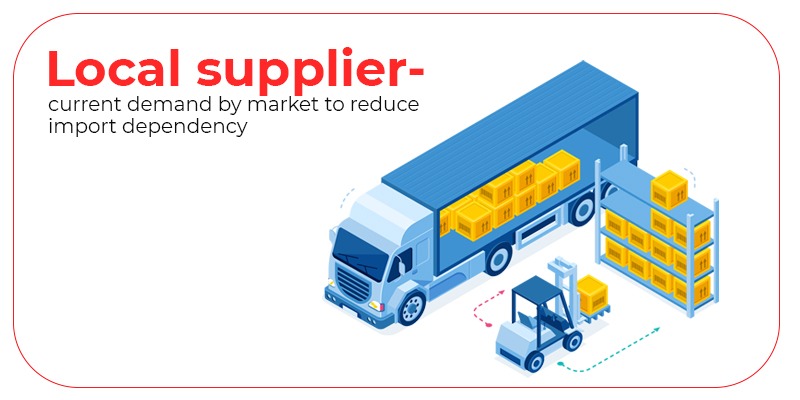Market Summary on atomized metal powders:
• On the basis of end-use, the pyrotechnics industry represents the biggest end use segment.
• On the basis of technology, atomization represents the leading technology to produce atomized metal powders.
• Based on region, the market has been segmented into North India, South India, West India and East India.
The automotive industry has traditionally been the most significant end user of metal powders. However, the market continues to develop due to upsurge in demand for metal powder for additive manufacturing, powder metallurgy, metal injection molding, etc. Increasing demand for lightweight metal parts in automotive as well as aerospace & defence are benefitting metal powders, which will lead to steady demand over the coming years.
Key players in metal powder market are engaged in acquisition, expansion, and collaboration for creating a strong foothold in this landscape. For instance, these key players are acquiring regional players, which helps them strengthen their footprints in regional markets across the globe.
Metal powder has been consistently implemented for automotive and aerospace & defence component manufacturing, which helps in reducing the weight of components by almost 50%. Also, increasing adoption of additive manufacturing in aerospace and healthcare industries is boosting demand for metal powder. But due to a slight slowdown in manufacturing and supply chain activities as a result of the ongoing COVID-19 pandemic, demand for metal powder has seen a decline. In regions such as South Asia & Pacific, Europe, and North America, with a number of end users affected, supply and demand shortages are expected to affect market growth. However, consumption will improve as economic recovery is expected after stabilization of the pandemic.
What’s the Market Share of Iron Powder?
Over the forecast period, the iron powder segment will continue to account for more than 80% of the global share by material. According to Persistence Market Research, by the end of 2031, the segment is projected to hold almost 80% of the market. Owing to its versatile advantages as a filler material and in welding, its finds wide application across various end-use cases, including automotive, diamond cutting tools and aerospace, which drives its dominant market share.
Current import situation in India:
Imports to India soared 7 percent year-on-year to USD 40.55 billion in February of 2021, preliminary estimates showed.
As we all know, a country’s importing and exporting activity can influence its GDP, its exchange rate, and its level of inflation and interest rates. A rising level of imports and a growing trade deficit has is having a negative effect on India’s current exchange rate.
The factors that influences the value of a country’s exports and imports in general especially the atomized metal powders are as follows:
• The country’s inflation rate: If the country has a relatively high rate of inflation, domestic households and firms are likely to buy a significant number of imports.
• Productivity
• Marketing
• Foreign GDP
Exchange rates, competitiveness, growing globalization, tariffs and trade bariers, transportation costs, languages, cultures, various trade agreements affect companies by its decision to trade internationally. The exchange rate is the price of one currency in terms of another.
7 Most Influential Factors Affecting Foreign Trade of atomized metal powders are
• 1) Impact of Inflation:
• 2) Impact of National Income:
• 3) Impact of Government Policies:
• 4) Subsidies for Exporters:
• 5) Restrictions on Imports:
• 6) Lack of Restrictions on Piracy:
• 7) Impact of Exchange Rates:
Measures to be taken:
How to Decrease Imports/Increase Exports of atomized metal powders?
1. Taxes and quotas. Governments decrease excessive import activity by imposing tariffs. …
2. Subsidies. Governments provide subsidies to domestic businesses in order to reduce their business costs.
3. Trade agreements. …
4. Currency devaluation.
Successful strategies to help developing local manufacturers boost exports
1. Creation of duty drawback schemes. …
2. Increasing the availability of credit. …
3. Simplifying regulation. …
4. Improving cooperation among economic actors. …
5. Combining short-term and long-term export growth policies.
Overall, to reduce dependence on imports of atomized metal powders, an import tariff is typically recommended as the first-best (lowest-cost) policy instrument for achieving this non-economic objective. This note shows that while this is correct if the objective is to restrain imports to a certain quantity, it is not correct if the target is to reduce imports to a certain percentage of domestic consumption. In the latter case, a tariff-funded subsidy to producers is also required, the extent of which is larger the smaller the domestic price elasticities of demand and supply for the commodity.
Conclusion:
Last but not the least, while reducing the atomized metal powder import bill seems to be the best way to permanently deal with rising energy costs, the plan can be attained only over a longer period of time. However, the current price rise needs to be dealt with soon in order to reduce the burden on citizens, prevent high inflation and slower economic growth.







